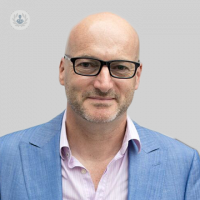Correcting abnormal heart rhythms: what is cardiac ablation surgery?
Written by:The heart has its own inbuilt electrical system, which sends signals throughout its upper and lower chambers, and helps it to beat in a regular rhythm. Sometimes the conduction pathway becomes blocked or damaged, which can cause the heart to beat too quickly, slowly, or at an irregular rhythm. This problem can be resolved through cardiac ablation surgery. We speak to leading consultant cardiologist Dr Martin Lowe, who explains everything you need to know about cardiac ablation surgery.

What is cardiac ablation surgery?
Cardiac ablation surgery is used to correct abnormal rhythm problems by treating abnormal electrical tissue in the heart by burning or freezing the tissue to restore a normal heart rhythm. Cardiac ablation surgery is sometimes an option for patients who have taken medication without effect.
What does the cardiac ablation procedure consist of?
The procedure consists of gently passing electrodes through a vein at the top of the leg (the groin area) until they reach the correct position in the heart. The problem area of the heart where irregular signals are being emitted will have been identified prior to the procedure, and once the abnormal electrical circuit is found, the ablation electrode or catheter is used to burn or freeze the tissue inside the heart. Either heat energy is applied (radiofrequency), or cold (cryo), through a catheter, which is a very thin flexible wire that can be placed directly onto the area responsible for the arrhythmia in the heart. This modifies the abnormal tissues in the heart to prevent irregular signals.
The surgery usually takes between one and four hours depending on the type of procedure. It is often carried out under general anaesthetic, which means the patient is not awake during the procedure. The procedure is often carried out as a day-case, but it can sometimes be a short stay procedure, where the patient stays in the hospital overnight afterwards.
Which conditions are treated with cardiac ablation?
Cardiac ablation can be used to treat a full range of heart rhythm problems, the main ones being atrial fibrillation, heart flutter (otherwise known as heart palpitations, where you feel your heart is beating too hard, or too fast), supraventricular tachycardia (SVT) and ventricular tachycardia.
What are the risks of cardiac ablation?
There is a small amount of risk associated with cardiac ablation which will be explained by the doctor prior to surgery. Small risks include bleeding where the catheter is inserted, bruising, and the possibility of blood collecting under the skin (haematoma).
In some cases, it is possible that a pacemaker is needed if the heart goes too slowly following ablation surgery.
Patients will most likely feel tired following surgery, but most people will be back to normal after a couple of days.
Although there are some small risks, the benefits of surgery outweigh the risks associated with heart rhythm irregularities.
What happens after the procedure?
Quality of life is generally improved for patients who have undergone a cardiac ablation procedure. It is an effective procedure which can successfully stop abnormal heart rhythm, or prevent it from recurring.
After the procedure it’s important for the patient to lie flat on their back for a few hours – an overnight hospital stay may be advised. After a few days, the patient can expect to start feeling normal again, and commence daily tasks without trouble. The doctor or specialist will advise aftercare, and what precautions should be taken. Recovery from the procedure is normally fairly quick and painless.


